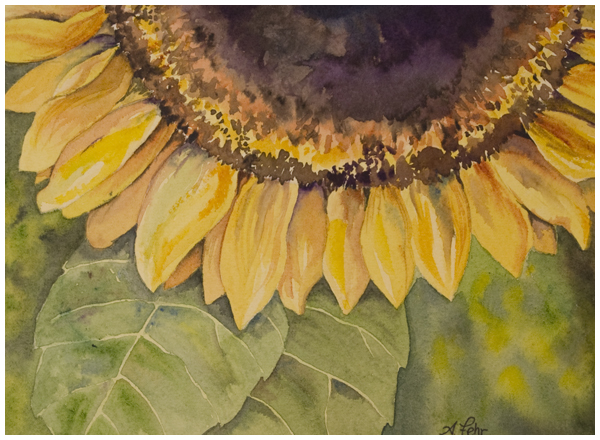Sunflower Suggestions
Last night in our watercolour class, I started the class on a step-by-step painting of a sunflower. This sunflower:  "Lit" watercolour by Angela Fehr
"Lit" watercolour by Angela Fehr
You may recognize it as the demonstration painting we did in my spring class sessions - why mess with a good thing? The nice thing about painting a sunflower for a beginner watercolour class is the repetition and practice the students get while painting the petals. We alternate petals across the page, never painting two petals side by side, not just because we don't want the colour to bleed, but because as the students get comfortable with the methods used to paint the petals, their petals change and begin looking better as they go along. Of course, if they were working from right to left, that difference would be more obvious. By alternating petals and moving all over the page, the less "skilled" petals are mixed with the more technical petals and mistakes or awkward areas aren't as obvious.
We also talk nearly every week about colour theory. This week we were discussing complementary colours, or colours that are opposite each other on the color wheel. Because I don't use black in watercolour painting, when I want to "gray" a colour, or make near-black hues, I mix complementary colours. In this sunflower painting, teeming with yellow, I used purple to mix my darks (added to yellow I get a greyish neutral shade) and also purple on its own to make my yellows pop. If you look carefully, you can see purple in some of the areas where the petals touch the flower center, and in the center itself. The key is not to overdo it - you don't want your painting screaming "Purple!"
One more thing we discussed was in painting petals that are the same colour and side by side, it's important to use a multitude of colours in those petals. With a light touch, of course. The petals have a variety of yellows, a little orange, a little brown, a little green and of course the purple we discussed. Petals that are under other petals are darker. Petals that are beside really warm petals (primarily yellow or orange) have a little cool colour in their shadow areas (green/blue/purple based colours). Petals with cooler colours (greenish yellows, even lemony yellows) need warmer toned shadow areas (brown/rust/orangey greys). This is the variety that makes watercolour interesting and fun. I love dropping little splashes of crazy colour into a wet, freshly painted area, and seeing it flow!

